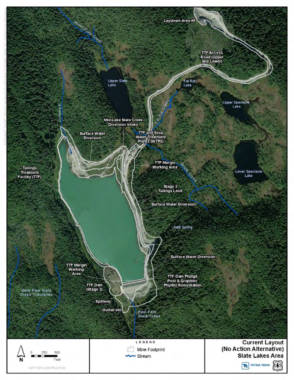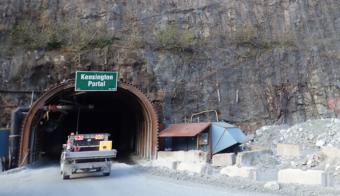
Coeur Alaska reported its Kensington Mine produced around 125,000 ounces of gold in 2020. And its most recent report suggests it’s on track for a similar yield this year. At current prices, that’s around $225 million worth each year.
“Gold prices have been excellent,” said Coeur Alaska’s general manager Mark Kiessling. “They came up quite a bit in 2019 and 2020. They’ve come down a little bit and 2021. But it’s still been very promising.”
The mine is on a patchwork of leased private land and Tongass National Forest in an area between Juneau and Haines east of Lynn Canal.
It’s one of the region’s largest private sector employers with around 360 employees. But in order to stay open through 2033, the mine needs to expand its footprint.
Future of mine depends on storage space
The mine produces gold concentrate, so all that leftover rock has to go somewhere. And the mining company says it’ll be out of space in a few years.
The way Kensington disposes its mine waste makes it somewhat unique in this country. Thanks to a favorable decision in 2009 by the U.S. Supreme Court, the Chicago-based mine company was allowed to convert a natural lake into a tailings pond, which has run into challenges.
There’s an 88-foot dam in place now to hold back about 4 million tons of liquid mine waste that contains heavy metals from the ore. This tailing treatment facility, formerly known as Lower Slate Lake, lies upstream from Berners Bay which makes conservationists — and some federal regulators — nervous should it ever fail.
NOAA Fisheries scientist Sean Eagan has helped outline the agency’s concerns to the Forest Service.
“When you raise the dam by 36 feet, and add another 4 million cubic yards of material, the chance of that dam failing increases,” Eagan said. “And should it increase, the tailings will spill out more broadly into Berners Bay.”
Forest Service OKs nearly doubling tailings pond
The U.S. Forest Service has reviewed and tentatively green-lit the mine’s expansion. That would increase the tailing treatment facility’s capacity to 8.5 million tons of mine waste.
It’s working through the environmental review to get its permits. Federal law required the Forest Service to consult with NOAA Fisheries scientists.
Senior Forest Service officials in Alaska and Washington D.C. declined to answer questions or make anyone available for an interview request.
“The agency works closely with the state and other federal agencies with regulatory authority to ensure that measures are in place and followed to protect water quality, other resources, and nearby aquatic habitats,” the agency wrote to CoastAlaska. “When mineral extraction is proposed, the plan of operations is reviewed to ensure the protection of communities and natural resources. The plan of operations must include steps taken to protect water quality and aquatic habitats by minimizing erosion and preventing tailings or waste from contaminating water bodies or other areas.”
NOAA Fisheries’ role is advisory. But it’s asked the Forest Service to consider alternatives. It says Kensington should instead filter out the water from its tailings so they’d be stored in a more solid form.
Feds urge Kensington to consider ‘dry stacking’ tailings
NOAA Fisheries scientist Molly Zaleski says filtered tailings are already being done in the region’s other major mine on Admiralty Island.
“That’s something that we already have at Greens Creek Mine. So we knew that that’s something that can be done in Southeast Alaska,” she said.
Kensington’s engineers and consultants looked into it but the company says it’s not feasible.
“Just because it works at one operation and one area in Southeast Alaska doesn’t mean it’s going to work in another,” Kiessling said.
He says there’s the high rainfall on Lynn Canal could make it a “muddy, soupy mess.”
“The whole concept behind filtered tailings is you remove the water from the tailings, and that allows you to stack it up,” he continued. “And if you add the water back in and precipitation, it makes it almost impossible to stack it up.”
It’s not a direction the Forest Service is pushing for either. That was laid out in its July record of decision which gave provisional approval to raising the dam to a total height of 124 feet — easily the largest tailings dam in Southeast Alaska.
The Forest Service’s own analysis has suggested that whether Kensington’s mine waste is liquid or solid it presents an equal danger, which it characterized as “very low risk.”
Tailings dam would have ‘indefinite service life’ after mine’s closure
The Alaska Department of Natural Resources has been broadly supportive of the expansion.
But Alaska’s head dam safety engineer, Charlie Cobb, found fault with some of the Forest Service reasoning when it assessed relative risks.
“Effectively stating that the dam safety and geotechnical stability of all alternatives are essentially the same and all are subjectively considered as ‘very low risk’ prevents an effective and defensible comparison,” Cobb wrote in more than 80 pages of technical comments submitted on behalf of state permitting agencies.
“The failure mechanisms on those structures would be different. So the probabilities of those failures would be different,” Cobb said in an interview. “And the consequences of those failures would be different. So rather than being subjective about it, it would be better at least if they had some relative comparison that said, one might be higher or lower, or the consequences might be different.”
But any final dam would have to be approved and inspected by the state’s dam safety office. And Cobb says as long as the dam is built to standard, raising its height shouldn’t increase its risk of failing.

No immediate threat to ecosystem
To be clear, none of the federal agencies are suggesting Kensington Mine’s dam is an immediate threat to Lynn Canal.
“We do not feel that this dam is likely to fail in the next 10 years while the mine is operating,” said Eagan, the NOAA scientist. “We’re not even suggesting the next 20 years or 30 years. It’s more a process of the dam will be there for a very, very long time.”
Cobb says a dam’s service life depends on its maintenance and care.
“It’s not that you can’t design for something for a very long time frame,” he added. “But you do have to provide for the resources necessary to inspect and monitor that dam and do maintenance on it for an indefinite period of time.”
The expansion plan has generated a lot of interest — more than 400 comment letters from Alaskans and organizations expressing a mixture of support as an economic engine or as an ecological threat.
A formal objection period expires Aug. 23. But barring a major challenge the Forest Service’s decision becomes binding and Kensington will be able to expand its operations and stay in business through at least 2033.

